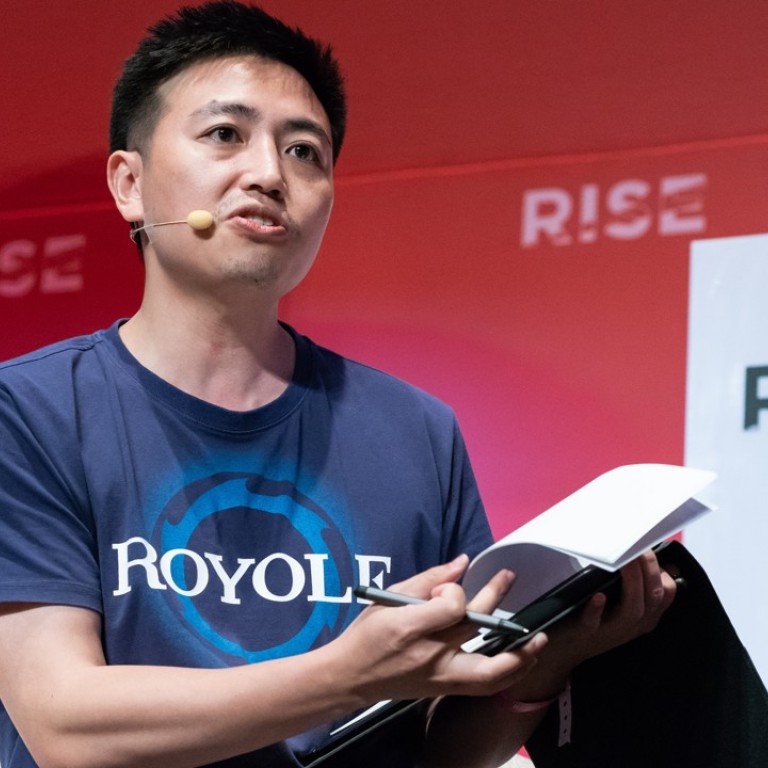
Meet the Shenzhen billionaire behind the world’s thinnest flexible display
Bill Liu, co-founder of Royole Corp, sees the firm’s ultra-thin and flexible high-resolution displays being used in smartphones and various applications
The idea came to him while lounging on the Stanford University lawn as an electrical engineering student: a flexible display that could be tucked away like a pen.
“Big screens that we can roll up and put in our pocket,” said Bill Liu, 35, co-founder, chairman and chief executive of Shenzhen-based unicorn Royole Corp.
Liu has been chasing that dream ever since, and after showing the world’s thinnest flexible, full-colour smartphone display in 2014, he now has a long list of venture capitalists backing him.
Following a stint as a research scientist at International Business Machines Corp in New York, Liu moved to the southern coastal city of Shenzhen and founded Royole with two other engineers with Stanford backgrounds.
Now in its sixth year, the start-up was valued at US$5 billion in its latest Series E round of funding. Many of its 2,000 employees are working to mass produce the displays at a Shenzhen production campus built with Royole’s cache of venture capital money.
Liu sees an opportunity to change one of the most fundamental human-machine interfaces of our time. By offering a solution to the conflict between visual experience and portability, he figures Royole can overhaul the devices by which most information is absorbed these days.
“People really want to see beautiful, high-resolution big screens, which is why TVs and theatres keep getting bigger,” Liu said. “But it’s at conflict with portability. If we can make something that combines both in one device, it can be amazing.”
Company filings show Liu has about a 42 per cent stake of Royole, giving him a US$2.1 billion fortune, according to the Bloomberg Billionaires Index. Co-founders Peng Wei and Xiaojun Yu, who also studied at Stanford, have smaller stakes.
Royole’s line of products include 3D mobile theatres, “wearable” flex displays and a smart writing pad, which it sells on Amazon.com, JD.com and flagship stores in China, the United States and Europe.
But the company’s main source of revenue is business-to-business sales of its technology solutions, such as a lamp by China’s Opple Lighting, which can be adjusted with touch technology built into the stand.
Liu said he is working on potential deals with smartphone manufacturers as well as carmakers interested in Royole’s curved dashboard. A partnership with Chinese athletic goods maker Li-Ning is also in the works.
Flexible displays, including the curved design used by Samsung Electronics, account for about a third of total smartphone display shipments, said Jerry Kang, an IHS Markit analyst. He said the technology will have a majority of the market by 2022, when shipments of smartphone displays are expected to have tripled.
“Mobile brands will try to make their products with larger screens in a more convenient way,” Kang said.
Royole is not the only game in town or even the biggest. BOE Technology Group’s flexible active-matrix organic light-emitting diode, or AMOLED, display production line in the southwestern city of Chengdu began running on May 11, the company said on its WeChat account. Total investment for the line is 46.5 billion yuan (US$6.8 billion).
Royole’s investors include Knight Capital, IDG Capital, Poly Capital Management, AMTD Group, the funds of Chinese tycoon Xie Zhikun and the venture capital arm of the Shenzhen government.
Liu is one among a growing number of Chinese billionaires, including biotech tycoons Lou Jing and Frank Zhang, who earned degrees in the US before returning to the homeland to do business.
After years of struggling to stop the outward migration, the Chinese government is making headway in luring foreign-educated Chinese back home.
The Centre for China and Globalisation, which publishes a list of the top 50 returnees based on innovation and entrepreneurship, called the wave the largest since China’s civil war ended in 1949. Chinese state media lauded the movement as a “reverse brain drain”.
Liu said he has found inspiration in Shenzhen entrepreneurs such as Huawei Technologies founder Ren Zhengfei, as well as those with roots in Silicon Valley. He recently met Apple co-founder Steve Wozniak on a panel near Shenzhen, where the US technology giant is planning a research and development centre.
“Steve Jobs was a great entrepreneur,” Liu said of Apple’s late chairman. “But I don’t want to be any one of them. Everyone’s different. What really matters is to digest the spirit from other great people.”

